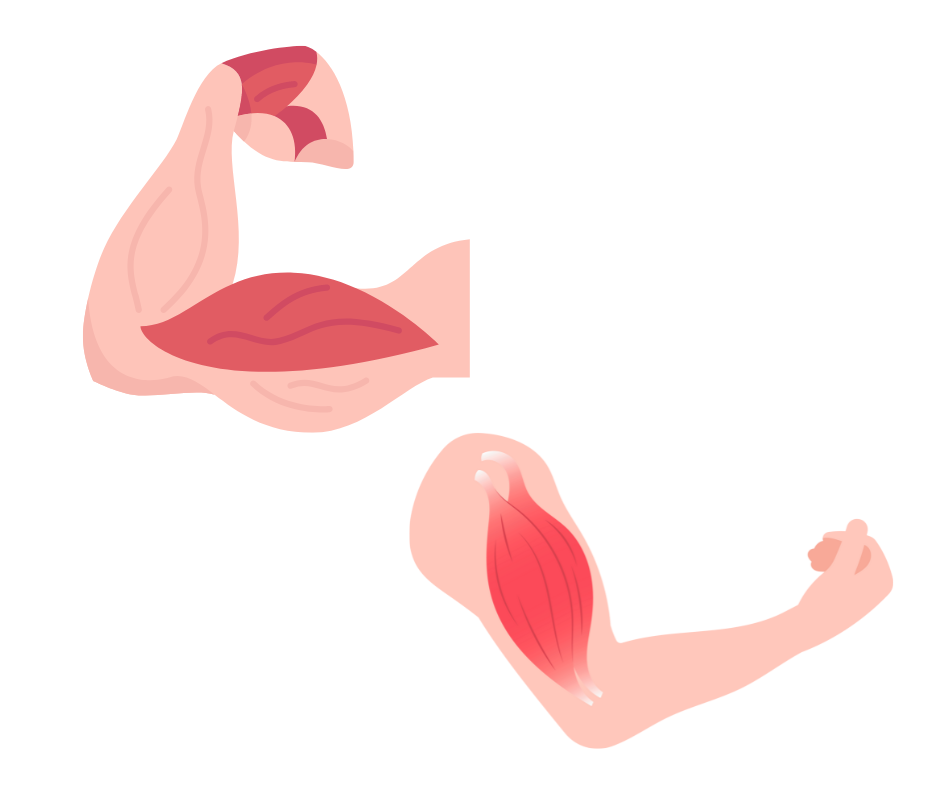
Gaining muscle mass is often regarded as the foundation of any fitness program, regardless of whether your objective is to improve endurance, boost strength, or simply look good in a T-shirt. You can acquire important insights into your progress and make well-informed decisions regarding your food and exercise regimen by keeping a precise record of your muscle mass growth. This article is meant to serve as your all-in-one resource for learning how to track and increase your muscle mass.
Introduction to Muscle Mass
The quantity of muscle in your body as opposed to fat and other non-muscular tissues is referred to as muscle mass. Numerous factors, such as genetics, nutrition, exercise, and lifestyle, might have an impact on it. Measuring these changes on a regular basis can help you track your muscle mass gains and assess how effective your workout program is.
Why Tracking Muscle Mass Gains is Important
Tracking muscle mass gains is crucial for several reasons:
- Progress Measurement: Regular monitoring allows you to see if your fitness program is effective.
- Motivation: Observing tangible progress can be incredibly motivating.
- Adjustment: Allows you to tweak your workout and diet plans based on your progress.
- Health Monitoring: Keeps you informed about your body’s overall health.
Methods to Track Muscle Mass Gains
- Body Measurements:
- Tape Measure: Measuring the circumference of various body parts like biceps, chest, and thighs can provide insights.
- Skinfold Calipers: Used to gauge body fat percentage to get an overall picture of muscle mass vs. fat.
- Scales and Devices:
- Bioelectrical Impedance Scales: Assess body composition by passing a small electrical current through the body.
- Smart Scales: Provide detailed metrics like muscle mass, fat percentage, and water content.
- MRI and DEXA Scans:
- MRI (Magnetic Resonance Imaging): Provides detailed images of muscle tissues.
- DEXA (Dual-Energy X-ray Absorptiometry): Measures bone density and body composition; highly accurate but costly.
- Fitness Apps and Trackers:
- Apps like MyFitnessPal and Fitbod: Can track workouts and nutrition, helping you monitor muscle-building progress.
- Strength Tests:
- 1RM (One Rep Max): Testing the maximum amount of weight you can lift in a single rep for key exercises can be a functional indicator of muscle strength and growth.
Factors Influencing Muscle Mass Gains
Diet and Nutrition
- Protein Intake: Essential for muscle repair and growth. For every kilogram of body weight, aim for 1.2 to 2.2 grams of protein.
- Carbohydrates: Provide the energy required for intense workouts.
- Healthy Fats: Supports hormone levels which are crucial for muscle growth.
- Hydration: Ensures optimal performance and recovery.
Exercise Routine
- Resistance Training: Lifting weights is the most effective way to build muscle mass.
- Compound Movements: Exercises like deadlifts, squats, and bench presses target multiple muscle groups.
- Isolation Exercises: Focus on specific muscles to enhance size and strength.
- Progressive Overload: Gradually increasing the weight you lift to continually challenge your muscles.
Recovery
- Sleep: Aim for 7-9 hours of quality sleep per night.
- Rest Days: Allow muscles to recover and grow.
- Active Recovery: Activities like walking or stretching can aid recovery.
Tracking Muscle Mass Gains Effectively
Setting Realistic Goals
Start by setting realistic, achievable goals. Use the SMART criteria:
- Specific: Specify your desired outcome.
- Measurable: Ensure you can track progress.
- Achievable: Set feasible targets.
- Relevant: Align goals with your overall fitness objectives.
- Time-bound: Have a deadline to stay focused.
Regular Monitoring
Consistency is key:
- Weekly Check-ins: Take measurements every week.
- Monthly Assessments: Use more accurate methods like DEXA or bioelectrical impedance monthly.
Keeping a Journal
Maintain a fitness journal to record:
- Workout Routines
- Diet Plans
- Physical Measurements
- Personal Observations
Common Challenges and Solutions
- Plateaus: Change your workout routine or increase the intensity.
- Injury: Incorporate rest and adapt exercises; consult a professional if needed.
- Diet Slips: Plan meals and track food intake.
- Lack of Motivation: Training with a partner or hiring a trainer can help.
Advanced Tracking Techniques
Wearable Technology
- Fitbit and Apple Watch: Track overall activity and can provide indirect insights into muscle gains via activity levels and workouts.
- Whoop Strap: Offers detailed recovery metrics, which correlate with muscle growth and overall fitness improvement.
Online Communities and Forums
- Engagement: Joining forums like Reddit’s r/fitness or specific fitness groups on social media can provide motivation and tips on tracking progress.
- Feedback: Share your journey and get advice from others who have achieved similar goals.
Professional Assessments
- Personal Trainers: Regular evaluations from a certified trainer can offer insights and personalized recommendations.
- Dietitians/Nutritionists: Consult for tailored dietary plans to optimize muscle mass gains.
Optimizing Your Muscle Mass Gains
Periodization
- Cycling: Alternate periods of high-intensity training with recovery phases to prevent burnout and overtraining.
- Variety: Incorporate different training techniques like hypertrophy, strength, and endurance phases.
Supplements
- Protein Powders: Convenient sources of high-quality protein.
- Creatine: Supports high-intensity performance and muscle growth.
- BCAAs (Branched-Chain Amino Acids): Help reduce muscle soreness and speed recovery.
Mental Factors
- Visualization: Mental imagery can enhance performance and focus.
- Mindfulness: Practices like meditation can reduce stress and improve recovery.
Real-life Case Studies
Case Study 1: John’s Journey to Increased Muscle Mass
John, a thirty-year-old office worker, began using a smart scale and a fitness app to monitor his gains in muscle mass. Over the course of six months, John experienced notable improvements after changing his diet to include 1.8 grams of protein per kilogram of body weight and combining resistance exercise and compound movements. He gained five percent more muscle mass, which completely changed his body and gave him more self-confidence.
Case Study 2: Maria’s Transformation
Maria, a student of twenty-five, used a fitness tracker and body measurements. She supplemented her vegan diet with plant-based protein sources and sought guidance and support from internet networks. Maria was able to add a good amount of muscle mass over the course of a year, as shown by a substantial increase in her overall strength and a 3 cm rise in her bicep circumference.
FAQ
How often should I track my muscle mass gains?
To maintain consistency and accurately monitor long-term growth, you should strive for measurements every week or every two weeks. For more thorough insights, advanced techniques like DEXA scans can be performed on a monthly or quarterly basis.
What are the best exercises to build muscle mass?
Combine isolation workouts that target particular muscle groups with complex movements such as squats, deadlifts, and bench presses.
How can I adjust my diet to maximize muscle gains?
Make sure your consumption of carbohydrates, healthy fats, and protein is balanced. As a general guideline, aim for 1.2 to 2.2 grammes of protein per kilogram of body weight.
What should I do if I hit a plateau?
Think about adding new exercises, lifting heavier weights, or altering your fitness regimen. Make sure your diet is sufficient and seek advice from a fitness expert if required.
Is it necessary to use supplements to gain muscle mass?
Supplements such as creatine and protein powders are not necessarily necessary, although they can be helpful. Your dietary needs can also be satisfied by a well-balanced diet.
How important is recovery in the muscle-building process?
Because this is the time of muscle growth and regeneration, recovery is essential. Make sure you get between seven and nine hours of sleep every night, and schedule rest days.
Conclusion
Any fitness journey must include tracking your muscle mass growth because it gives you the information you need to improve your diet and workout routines. It’s possible to effectively track and maximize your muscle development by combining professional assessments, sophisticated scales, and body measurements. Maintain your motivation and consistency to reach your muscle-building objectives!
To obtain additional individualized assistance and advice, think about signing up for fitness newsletters or seeking counsel from fitness experts who can offer customized suggestions based on your unique progress.





[…] best time to exercise is whenever you can consistently fit it into your schedule. Some people prefer mornings, while […]